Pallet Shuttles vs. Dynamic Racks
A comparison of storage and handling methods
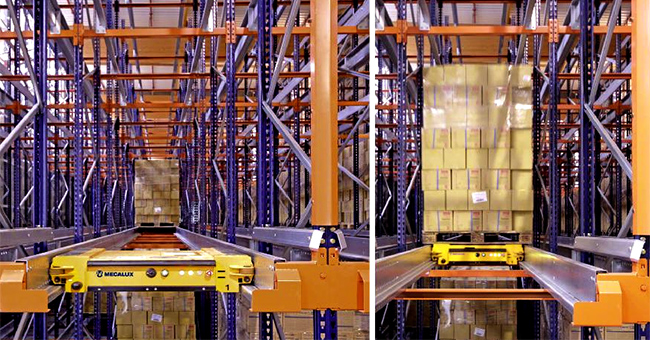
For high-volume pallet storage and retrieval operations, dynamic rack systems like pushback, drive-in or pallet flow allow maximum storage in a given area, but each have their limitations. In some instances, a pallet shuttle system may suit the needs of many operations. The costs and limitations are different for each storage method, as shown below.
Pallet storage and retrieval options
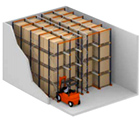 |
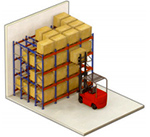 |
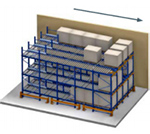 |
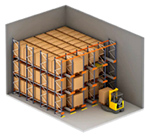 |
|
|---|---|---|---|---|
| Drive-In & Through | Pushback | Pallet Flow | Pallet Shuttle | |
| Application | LIFO or FIFO | LIFO | FIFO | LIFO/FIFO |
| Pallet Depth | Up to 8 | Up to 6 | Up to 20 | Up to 40 |
| SKU Selectivity | SKUs per Bay | SKUs per lane | SKUs per lane | SKUs per lane |
| Forklift Interaction | Forklifts enter the rack | No forklift entry | No forklift entry | No forklift entry |
| Load Interaction | No product contact | No product contact | Product contact | No product contact |
| Cost Range (per pallet) | $ | $$ | $$$ | $$ |
Application factors: first-in, first-out or last-in, first-out?
LIFO systems
LIFO (last-in, first-out) is an extremely common storage pallet storage method. Most dynamic racks rely on LIFO, with the exception of pallet flow systems, which are first-in, first-out systems. The big issue with all dynamic rack systems tends to be accessibility–the space savings means you’ll have limited access to your stored pallets. A selective system can’t store nearly as many pallets, but you can access all of them all of the time.
Pushback, drive-in and drive-through systems are last-in, first out access, and that works for many applications requiring deep lane storage. When you have higher picking volumes on a smaller pool of SKUs, these systems fit the bill. Drive-through systems can be either FIFO or LIFO, depending on layout or picking strategy. Pallet shuttles can be configured to work FIFO or LIFO. When loading and unloading are executed from a single lane in LIFO operations, pallet shuttles are more commonly used.
FIFO systems
Pallet shuttles and pallet flow systems are FIFO. Neither require the forklift to do more than access the pallet offered up by the system. Pallet shuttles should be used to completely load or unload an entire level. In the case of both flow and shuttles, you’ll need two aisles–one for loading and one for access. FIFO systems have more dynamic elements (shuttles or flow rails) that require maintenance, but enjoy a safety advantage because forklifts never enter the rack structure.
Read more: First-in, First-Out Considerations
Pallet depths: how deep can the system store pallets in a lane?
Since the mission of these systems is to pack more pallets into less space, this is a critical metric. The rule of thumb is that “more pallets = less access.” Pallet flow and shuttle racks can simply pack more pallets into a lane than drive-in or pushback systems, making them more space efficient.
Maximum pallet compacting
Pallet shuttles will let you go far deeper than any other system because they don’t rely on gravity or a forklift entering a deep lane. They also maximize the front-to-back storage capacity because they can control pallet placement more accurately.
SKU selectivity: how easy is it to select pallets?
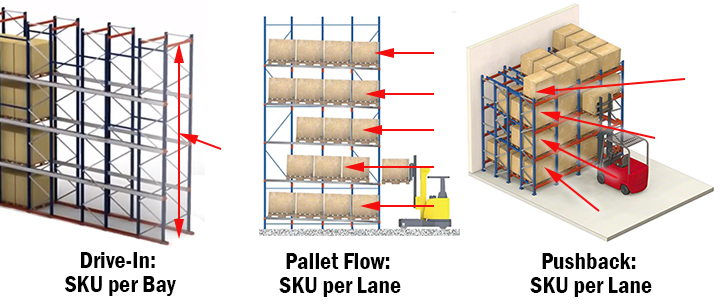
Selectivity tends to decline as storage density increases. Where selective racks allow you to pick any pallet at any point in time, all dynamic systems are more limited. Drive-in systems are limited to a single SKU per bay (for dynamic systems, that’s every level of one the pallet position from floor to top level), while pushback, flow and shuttle systems let you store a different SKU in every lane. You can place a different SKU on every level of a bay with those systems if desired.
- A bay is defined as one rack position vertically from the floor to the ceiling. In the drawing above, you can see that for the drive-in system, you can store one SKU per bay.
- A lane can be any beam or rail level within the bay. You can have five SKUs in one bay if you have five levels.
Because shuttles can access pallets from any position and move either direction, shuttles let you store pallets in deep lanes similar to flow systems or drive-in, with the ability to slot one SKU per lane.
Forklift interactions: do forklifts enter the rack structure or otherwise engage with the rack?

In most designs, forklifts only pick and place at the very front of a rack. When forklift operators must enter the rack structure, there are safety concerns due to collisions and component damage. Drive-in and drive-through systems are built with heavier structural components to handle potential collisions because forklifts constantly move inside the rack. This isn’t to say that other racks don’t present challenges due to forklift collision damage; they do. But the frequency of interactions should be managed in any case.
- Drive-in systems require a forklift to enter the rack so that it can place or pick pallets deep within the structure.
- Drive-through systems also require this, although you may be entering from either side to place or pull pallets.
- Pushback rack is accessible from the front. Drivers don’t need to enter the structure. They’re loaded and picked from the same aisle.
- Pallet flow systems don’t require forklifts to enter the rack structure. They’re stocked from the rear side and picked at the front.
- Pallet shuttle systems also don’t have any issues with forklifts engaging the rack, and are generally stocked and picked from one side of the structure.
Read more: Selectivity vs. Storage Density: Choosing the Right Pallet Rack for Your Application
Load interactions: how does the forklift and rack touch or impact the load?
Generally in pallet rack systems, there are few interactions between the forklift or rack and the load. Loads tend to sit on pallets, which are handled by forklifts and deposited on the rack’s beams, rails or guides. For some containers, there may be direct interaction with the product. Pallet shuttles sit beneath the pallet and move it without interacting with the load. This tends to be the case with pushback (it uses mechanical carts) and drive-in (which uses heavy steel rails to support pallets as they are picked and placed). It’s possible to have more load contact with the rack in pallet flow systems, but that isn’t always the case. Some non-palletized loads may have contact with the rack system in almost any storage concept. If your product sits directly on a rack, the system should be designed specifically for that load and application.
Cost factors: how expensive are the various high-density systems?
All dynamic rack storage systems are expensive, but are worth it when you must consolidate and access large numbers of pallets in a given area. This is why these systems are often used in cold or refrigerated storage, where every inch of space is expensive and efficient storage is critical.
- Evaluated on a cost-per-position perspective, drive-in rack–which doesn’t need dynamic components like carts, shuttles or rails–is the least costly high-density option.
- Pushback racks, which are also LIFO systems, rely on carts that drive up the cost per position.
- Pallet flow, which requires rollers the entire depth of the rack and braking systems on the picking side, is the costliest option. Its main costs reside in those dynamic components and potential maintenance of them. In a FIFO comparison, it delivers pallets to pickers faster than shuttles.
- Shuttles cost about the same per position as pushback racking, as the shuttles, power and maintenance add to cost factors.
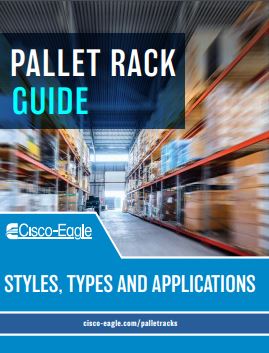 We can help you evaluate your next racking system. Contact us today for fast, professional assistance.
We can help you evaluate your next racking system. Contact us today for fast, professional assistance.
Download our guide to pallet racks
Cisco-Eagle is dedicated to helping you run your warehouse more safely and effectively. You can download our free Guide to Pallet rack for extensive information about racks, loads, specifications and operations.
Click to download (it’s a PDF file you can save to your drive for future reference).
Scott Stone is Cisco-Eagle's Vice President of Marketing with 35 years of experience in material handling, warehousing and industrial operations. His work is published in multiple industry journals an websites on a variety of warehousing topics. He writes about automation, warehousing, safety, manufacturing and other areas of concern for industrial operations and those who operate them.



